 Research Article
Research Article
Comparative Studies on Ring, Compact and Vortex Yarns and Fabrics
Lekhani Tripathi and Bijoya Kumar Behera*
Department of Textile and Fibre Engineering, Indian Institute of Technology Delhi, India
Bijoya Kumar Behera, Department of textile and fiber engineering, Indian institute of technology, Delhi, India.
Received Date: August 27, 2020; Published Date: September 08, 2020
Abstract
Ring, Compact and Air vortex spinning systems provide yarn with different structures and properties. Each system has its limitations and advantages in terms of technical feasibility and economic viability. In this research, 40’s Ne, 52:48 Polyester/Cotton blended yarns were produced on ring, compact and vortex spinning systems and woven fabrics were manufactured using these yarns [1]. The vortex yarn is poor in strength and elongation and is also having more irregularities and uneven compared to ring and compact yarns. The vortex yarn being porous has a higher diameter compared to ring and compact yarns, whereas the hairiness of vortex yarn is significantly low compared to ring yarn. The Comfort properties and Handle characteristics of the fabrics were studied apart from the other properties of the yarns and fabrics. Vortex yarn fabrics exhibit better absorbency, good air permeability, abrasion and pilling resistance. The hand values of the vortex yarn fabrics are not so satisfactory compared to ring and compact yarn fabrics; however, its other properties can be utilized for some specialized applications where fabric handle has a very least role to play.
Keywords: Air vortex spinning; Ring spinning; Compact spinning; Fabric handle; Comfort
Introduction
Ring, rotor, and air jet spinning are three major yarn production systems. Ring spinning is a continuous spinning system in which twist is inserted into a yarn by a tiny circulating traveler. Yarn twist insertion and winding take place simultaneously. Ring yarn structure generally accepted as the basic structure in spun yarn technology. In rotor spinning, fibers bundle from the sliver feed stock are separated into individual fibers with an opening roller in an air stream and separated fibers are re-collected in the rotor groove. Murata vortex spinning (MVS) based on the air jet spinning technology has become more and more popular because of high production speed. In the vortex system, drafted fibers are introduced into a spindle orifice by an air vortex. While entering and passing through the orifice, fibers are twisted by the swirling air. It can deliver yarn as high as 400mpm. The evolution of air jet spinning from the early Murata Jet Spinners (MJS) to the recently developed Murata Vortex Spinner (MVS) was because the MJS machine remains largely a cotton blend and 100% synthetic spinning technology. Fabrics made from MVS yarn are known to have resistance to pilling and good abrasion. They also have a very smooth fabric handle, unlike yarns that are spun using other types of systems. The said properties make the fabrics ideal for products such as blankets and even pieces of clothing that are worn in direct contact with the skin.
Compact Spinning allows the spinning mill to produce a true ring yarn, which in many physical yarn parameters (hairiness, tenacity and elongation) is vastly superior to non-compact ring yarn. The purpose of a genuine compact spinning process is to arrange the fibres in a completely parallel and close position before twist is imparted. The eliminated spinning triangle is a by-product of this concept. Close and parallel arrangement of fibres immediately before twist is imparted is responsible for the characteristic advantages of compact yarn.
Ortlek HG et al. [2] studied vortex spinning system and concluded that increase in spindle diameter reduces yarn irregularity and decreases yarn hairiness. Several other researchers have reported the influence process parameters on yarn properties in ring spinning, jet- ring spinning and open-end friction spinning systems [3,4]. (The role of yarn structure on fabric comfort properties is reported in a research work by Özdil N, et al. [5]. Compact spinning technology is an important system for staple yarn spinning in which the quality of cotton yarn is significantly influenced in terms of strength, elongation and yarn hairiness [6].
Image analysis method was used by Kilic M, et al. [7] to compare the packing densities of yarn spun by ring, vortex and compact. The structure of yarn depends on the arrangement of constituent fibers in the yarn. Influence of yarn structure on yarn irregularity is reported by Ishtiaque SM, et al. [8]. Zheng S, et al. [9] analyzed the distribution pattern of fibers in the yarn cross-section of vortex-spun yarn. It was observed that packing density in vortex spun yarn is lower in surface and center as compared to ring yarn, but effective packing density is lower for ring yarn. The amount of twist in the different layers of yarn, packing density , fiber per cross section , crosswise migration and irregularity of fiber displacement regulated by the structure of spun yarn [10,11].
Textile industry has been showing more interest to the air vortex spinning system due to some unique properties and higher production rates [12]. The knitted fabrics manufactured from air vortex yarn also show better resistance to pilling and abrasion , good durability and high moisture absorption [13,14]. The mechanical and thermal comfort were studied for the fabric produced from non-conventional blends like wool: silk, wool: linen, wool: cotton and silk: linen at different proportions and light weight constructions [15]. The tactile properties were studied by the mechanical and surface properties and hand values. The higher proportion of polyester gives higher total hand value, higher thermal insulation value, lower air permeability and lower moisture vapor transfer [16]. The comfort properties of fabrics woven from ring, rotor, friction spun yarns [17] and for ring and air-jet spinning were also studied by the researchers. In this research, comparative analysis of yarn and fabric produced on ring, compact and vortex spinning system using same material and identical process parameters were carried out.
Materials and Methods
Fibre and yarn production
40’s Ne polyester/cotton blended yarns in proportion of 52:48 were produced on vortex, ring and compact spinning systems and fabric samples were produced from these yarns for comparison . S6 cotton was used for this purpose. It has 2.5% of span length of 30 mm, uniformity ratio of 47% and fibre fineness of 3.8μg/ per inch. The polyester was 1.2 denier with mean length 38 mm. Process parameters maintained in the spinning systems are shown in the Table 1. The codes for vortex, ring and compact yarns are Y1, Y2 and Y3 respectively.
Fabric production
The yarns manufactured by all three spinning systems were doubled to produce 2/40s double yarns which were used to produce suiting (bottoms) fabric of approximate areal density of around 230gsm. 40’s single yarns were used to produce a shirting (tops) fabric with approximate areal density of around 130gsm. Thread density for suiting and shirting fabrics were kept (120x70 ) and (133x72) per inch respectively.
Evaluation of yarn properties
All the yarns were conditioned for 24 h under the standard laboratory conditions according to the ISO 139 standard. Single yarn tenacity was measured in Uster Tensorapid. The test was conducted in an atmosphere of 21 °C and 60% RH. The test length of the specimen is 500 mm and pre-Tension of 0.50cN/ tex is maintained during the tests. Unevenness was measured in Uster Tester 5-S800. The test carried out at 400mpm. The hairiness result was also obtained by the hairiness module of the Uster instrument.
Evaluation of fabric properties
All fabrics were conditioned for 24 h under the standard laboratory conditions. The woven fabrics were desized, scoured, bleached and calendared to give a ready for dyeing fabric which was used for all the testing purpose. Hydrogen peroxide 12-14 ml/kg and caustic 20 ml/kg were the main ingredients used for bleaching cum scouring process recipe. Fabric samples were checked for construction parameters such as EPI, PPI, Count, GSM, Thickness and Weave design. All fabric samples were tested for transmission properties (Air, Heat & Moisture), tensile strength, tear strength, stiffness, drapability, crease recovery, abrasion and pilling characteristics using ASTM standard. Adequate sampling was done to avoid biasing during sample selection.
Fabric construction parameters
The construction parameters were checked and confirmed by manual evaluation. The results are given in Table 2.
Table 1:Yarn Production parameters.
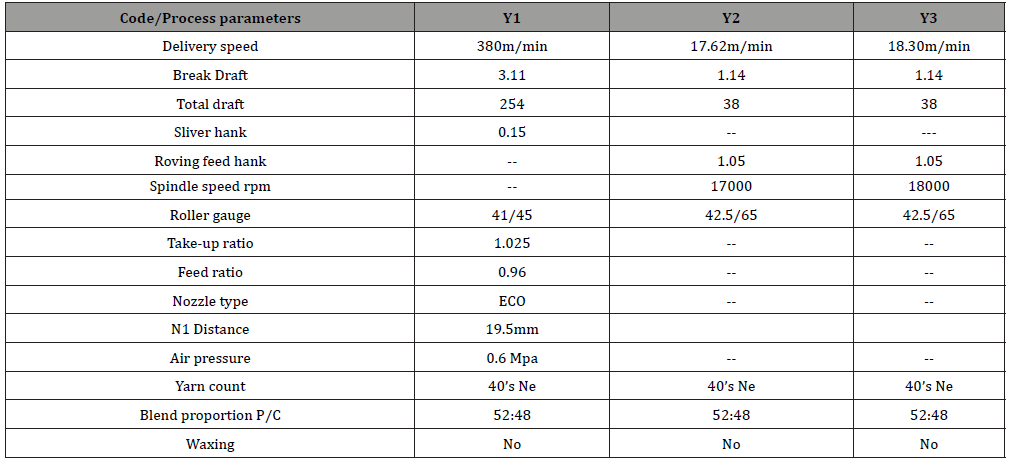
Table 2:Fabric construction parameters.

Low stress mechanical properties
The low stress mechanical properties such as tensile, shear, bending, compression, surface roughness and friction were measured on Kawabata fabric evaluation system (KESF) under the following testing conditions.
Tensile and shear testing: Tensile and shear testing were carried out on the KES-FB1 using sample size 20cm*20cm, maximum tensile strain 100%, maximum shear strain 8 deg (7mm), tensile strain rate 0.2 mm/second and shear strain rate 0.417 mm/second.
Testing of bending behavior: Bending behaviour was studied on the KES-FB2 (pure bending tester) keeping sample size 20cm*20cm, clamp interval 1 cm, rate of curvature 0.5 cm/second and maximum curvature ±2.5 cm.
Testing of compression behavior: The compression behaviour of fabric samples was tested on KES-FB3 (compression tester) using testing parameters: sample size 20 cm * 20 cm, area of compressing anvil 2 cm2, rate of compression 1 mm/50 seconds and maximum compression load 50 gf/cm.
Testing of surface properties: Surface friction and roughness were evaluated using the KES-FB4 keeping sample size 20cm*20cm, initial fabric tension 40g, fabric speed 1 mm/second, maximum sweep 3 cm, vertical load on surface roughness detector 10 g and weigh on surface friction detector 20g .
Drapability
Drapability of a fabric is determined using Drape meter and is expressed in terms of Drape Co-efficient. A circular specimen of diameter 254mm is supported on a circular disc of diameter 127mm. The unsupported area of the fabric drapes over the edge of the supporting disc. The drape coefficient, F is the ratio between the projected area of the draped specimen and its undraped specimen and its undraped area, after the deduction of the area of the supporting disc.

The thickness of the paper to trace the outline must be uniform. The small value of F indicates better drapability of the fabric and the large values of F indicate the bad drapability.
F = Drape co-efficient
The thickness of the paper to trace the outline must be uniform. The small value of F indicates better drapability of the fabric and the large values of F indicate the bad drapability.
Crease recovery angle
The ability of textiles to recover from creases is determined by measurement of its crease recovery angle. In this test the test specimen is first creased under a specified load for specified period of time and it then transferred to the angle measuring device where one of its ends is held in a spring loaded clamp while the other end is allowed to fall freely under its own weight. This clamped end is slowly rotated till the free end becomes vertical. The angle of deflection of the clamped end from the horizontal is read on a scale fixed to the ability of textiles to recover from creases is determined by measurement of its crease the moving clamp. This angle gives the measure of the crease recovery. The Shirley Crease Recovery Tester for fabrics was used to create a rectangular test specimen under a specified load for the specified duration of time and an arrangement to measure the crease recovery angle. Creasing is carried out by pressing the folded tests specimen under a load of 1 kg between two flat surfaces. The load is applied by mean of the dead weight of the upper flat surface.
Abrasion resistance and pilling behavior
Martindale abrasion fabric Tester is used to test the abrasion resistance of the fabrics. It uses the principles of two simple harmonic motions working at right angles. The woven sample was cut into 40mm diameter and subjected to a load of 200gms weight. The loss in weight of the samples was calculated after visual examination of the fabrics after 15000 revolutions.

Where, AR= Abrasion Resistance
Pills are small knots or balls of mixture of large number of small fibers accumulated at the surface of the fabric and entangled by the mild frictional action during processing or wearing. These are tested through the Martindale pilling and abrasion tester where the motion to the abrasion is changed to linear for 18000 revolutions. Pills are soft, firmly held on the surface of the material. The extent of pilling is assessed visually by comparison with the arbitrary standards.
Breaking force and elongation
To determine the breaking force and elongation of textile fabrics, a raveled strip test was used for woven fabrics, and a cut strip test for nonwoven, felted, and coated fabrics. Raveled strip test specimens used is 50 mm and 150 mm long. An equal number of yarns were removed (or 10 yarns each) from each side in order to obtain a 50 mm testing width, which explains the term “raveled” strip test. The specimens were clamped with a grip distance of 75 mm and pulled the strips in a tensile direction at 300 mm/min (12 in/min) until break. The test results that are relevant to these types of tests are the Breaking Force (Maximum Load) and Apparent Elongation. The humidity during the testing was 65% and temperature 22 ∘C.
Tear strength
Tear strength of fabric is measured by ASTM D2261 tongue tear method. Rectangular specimens are place into the CRE tester. One side of the cut end is clamped into the upper jaw and the other is clamped into the lower jaw. The jaws move apart at a constant rate until the fabric begins to tear. Depending on the nature of the specimen, the tearing force will be shown as a peak or a series of peaks. The highest peaks appear to reflect the strength of the yarns, fiber bonds, or fiber interlocks (individually or in combination) needed to continue a tear. Here Constant-Rate-of-Extension Tensile Testing Machine as used and 2 pre-cut samples (3” x 8”), one sample in both warp and weft were tested and the average values for peak strength were noted.
Air permeability
A circle of fabric is clamped into the tester and through the use of a vacuum; the air pressure is made different on one side of the fabric. Airflow will occur from the side with higher air pressure, through the fabric, to the side with the lower air pressure. From this rate of air flow, the air permeability of the fabric is determined. Each sample was tested at 10 different areas of the fabric considering the model sampling techniques for fabric testing. The measured air permeability values are expressed in volume of air flowing per unit area per unit time (cm3/cm2/sec) in SI units.
Thermal property
An Alambeta instrument was used to measure thermal conductivity, thermal resistance, and sample thickness and to calculate all the statistical parameters of the measurement. Objective measurement of the warm-cool feeling of fabrics, so called thermal absorptivity. The contact pressure was 200 Pa in all cases, and the CV values of all the samples were lower than 4%. The number of measurements was 5 for Alambeta tests and all the measurements were done in controlled laboratory conditions.
Water holding capacity
Fabric total absorbency which measures the water holding capacity of the fabric was determined by using 0.2% soap solution. A sample of size 20cm*20cm was dipped in the solution for 5 min and the hung vertically to allow any extra water to drop down. It was then weighed and the percentage gain in weight of the fabric sample was taken as a measure if the total absorbency of the fabric. Fabrics were conditioned in a standard atmosphere for 24 hours before all the tests were carried out.
Result and Discussion
Yarn Properties
The properties of single vortex, ring and compact yarns are summarized in Table 3.
Count and its variation: The Average counts of randomly selected samples were found to be close to the set/required count. The samples are of the acceptable quality as the average of count lies in the acceptable range i.e. +/- 1% of the set count.
Evenness and imperfections: The evenness and imperfections for different yarns are shown in Figure 1 and Figure 2 respectively. The percentage of mass variation along the length of the yarn is found to be maximum for the vortex yarn. This may be due to applying higher draft in one step of drafting which gives poor fiber control and hence higher variation. The compact yarn is more even yarn and has lowest U% of 9.9 %. The CV of count tests i.e variation of counts is highest for vortex yarns followed by ring and then compact yarns.
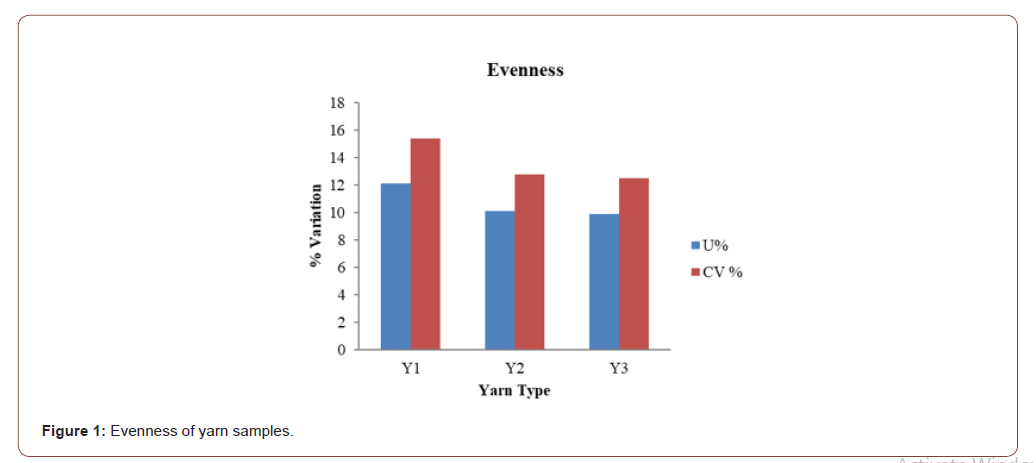
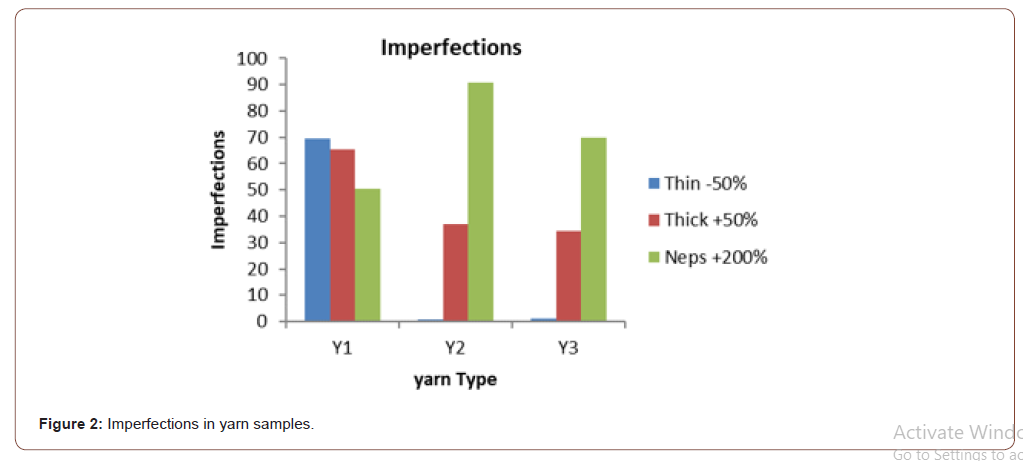
The vortex yarn showed a significant increase in all types of imperfections. The increase in imperfections was primarily due to drafting mechanism and the action of nozzle causing poorer fiber control. The thick & thin places imperfections were highest in vortex yarn and lowest in compact but the neps are found in greater number in ring yarn followed by compact and vortex i.e, vortex has least number of neps among the three yarns.
Hairiness: The hairiness values for different samples are shown in Figure 3. The hairiness value for ring yarn is highest. This is due to formation of spinning triangle formation at the front roller nip zone and the twisting mechanism. The hairiness for compact yarn is reduced by a positive control of spinning triangle by a suction enabled bottom roller which bids the wild fibers into the yarn body. The vortex spun yarn has a two-part structure (core and sheath) it is more rings –like appearance this two part structure (this can be simply revealed by untwisting a vortex yarn by hand) binds most of the fibers together into the yarn body and hence giving reduced hairiness value.
Tensile properties: Figure 4 shows the tensile properties (tenacity and elongation) of three different yarns. The tensile strength i.e. tenacity of the yarn is lowest in case of vortex yarns, here even some fibers are extracted by suction during twisting and there is an increase in the mean fiber length but still due to technological limitations the strength of these yarns are lower comparatively. Also, the elongation values for these yarns are low compared to ring and compact. The compact yarn shows highest tenacity due to even twist flow and controlled movement and binding of fibers. The elongation of ring yarn is higher due to its helical yarn and twist structure.
Yarn diameter: The mean diameter of three different yarns is shown in Figure 5. The diameters of the yarns were found by observing yarn under microscope as shown in Figure 6 and noting the diameter values. It is found that the diameter of vortex single yarn is higher than ring and compact single yarns, hence same trend is also followed in the double yarns. For the same yarn count we have a higher diameter and hence it is concluded that the vortex yarn is having higher porosity than the other two types of yarns.
Fabric properties
The Woven fabrics were manufactured by using 40’s yarn and 2/40’s yarn prepared by 3 different spinning systems and these trial yarns were used in the weft direction only. The Fabrics were given nomenclature as observed in Table 4. The overall fabric properties table is as shown below.
Tensile properties: The tensile strength and elongation% for three different fabric made from ring, vortex and compact spinning yarn are shown in Figure 7. The tensile results of fabric show that the warp wise tensile strength and elongation of all three suiting and all three shirting samples are approximately same. The weft wise tensile strength of vortex yarn Shirting fabric is higher than that of other two shirting fabric. Here the strength is recorded is strength of individual fibers and the fabric assistance due to cross direction threads. In case of suiting fabrics, the strength of compact yarn fabric is highest which is then followed by vortex and ring yarn fabric.
The Elongation of ring yarn fabric is least in case of both suiting’s and shirting fabrics. And the elongation of vortex yarn fabric is higher in case of double yarn (suiting fabric) fabrics and it is lower than compact yarn in case of shirting fabric.
Tear strength: Figure 8 shows the tear strength of different fabrics. The tear strength of vortex yarn is lower in both the cases i.e. suiting and shirting. This may be due to reduced strength of parent yarn. The compact yarn strength shows highest values among these fabrics.
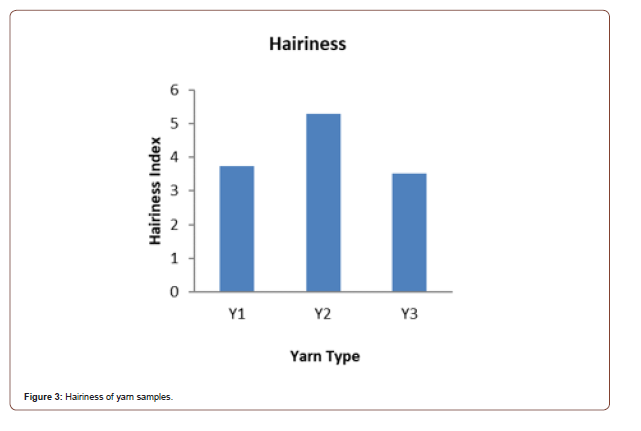

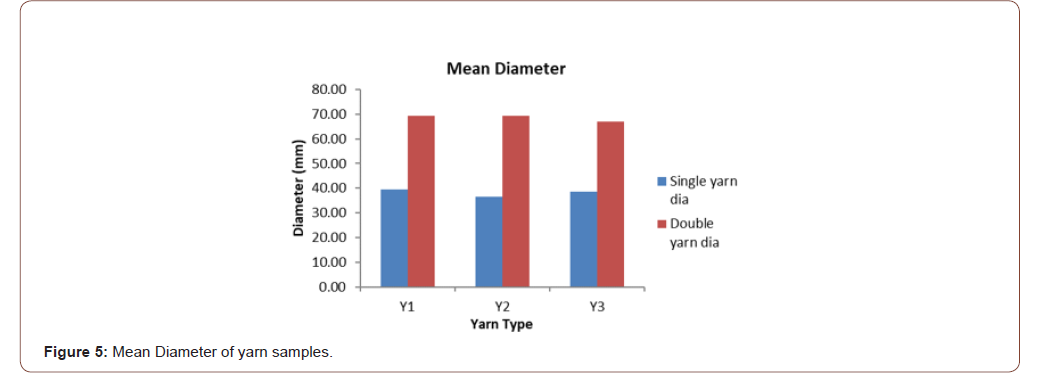
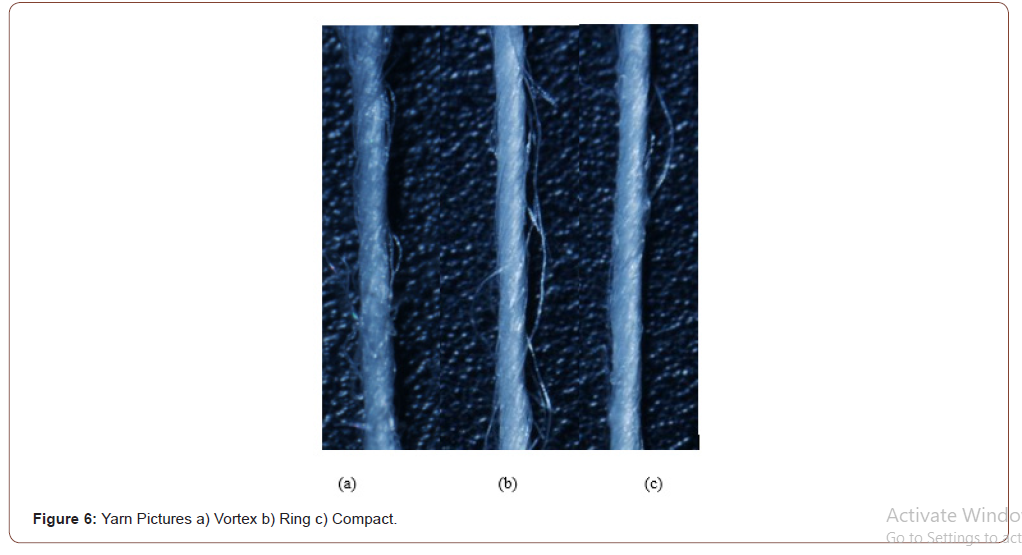
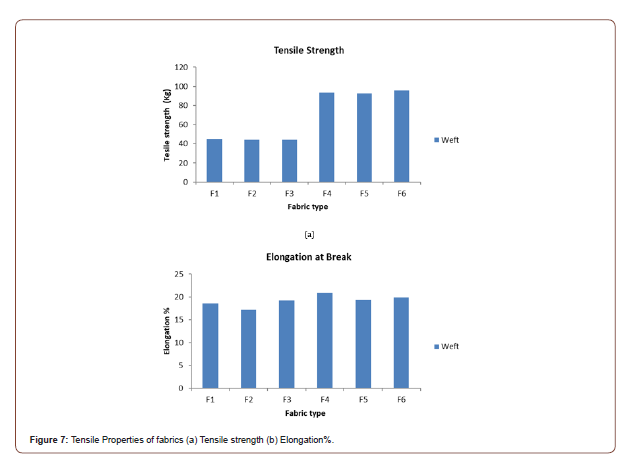
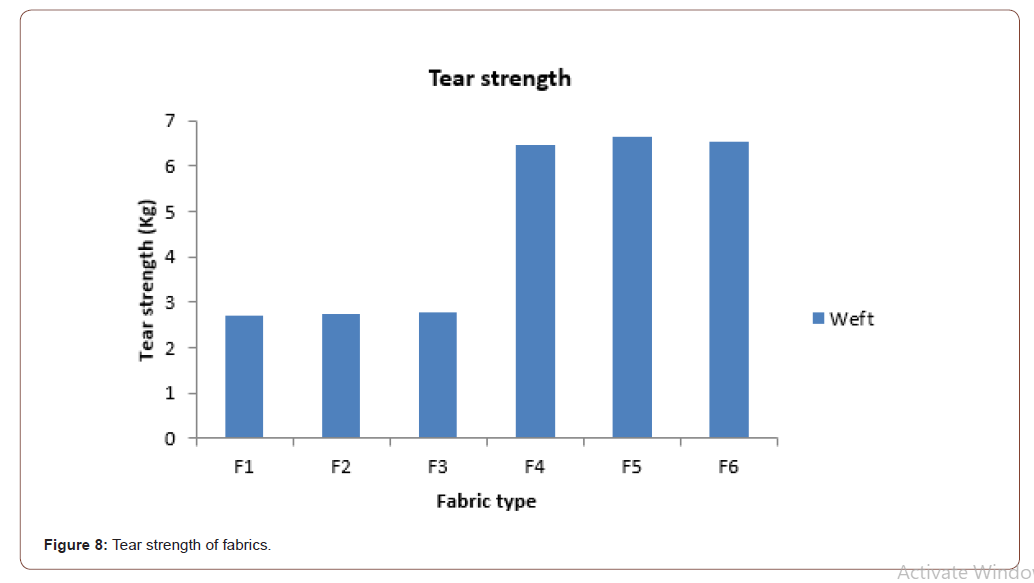
Stiffness/bending rigidity: Figure 9 shows the bending rigidity of different fabrics made of different yarns. The Bending rigidity of vortex yarn suiting fabric is lowest and in case of shirting fabric the bending rigidity or stiffness are comparably equal. The effect of yarn type on stiffness is less prominent in single yarn fabrics while this effect prominence is more in suiting fabric i.e. double yarn fabric.
Crease recovery angle: Figure 10 shows the crease recovery of different fabrics and it is concluded that the Crease recovery is least for vortex yarns in both shirting and suiting fabric. Due to unstable and unreal twist structure the application of load causes change in orientation of fibers and hence poor recovery. The highest crease recovery is observed in compact yarn fabrics.
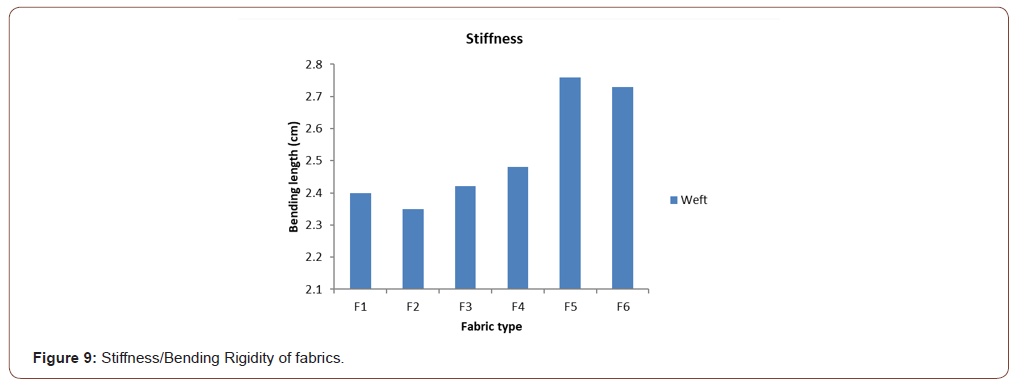
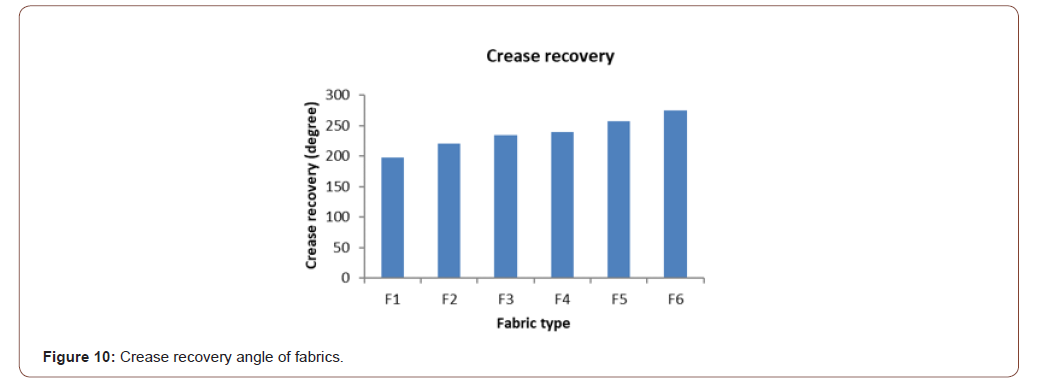
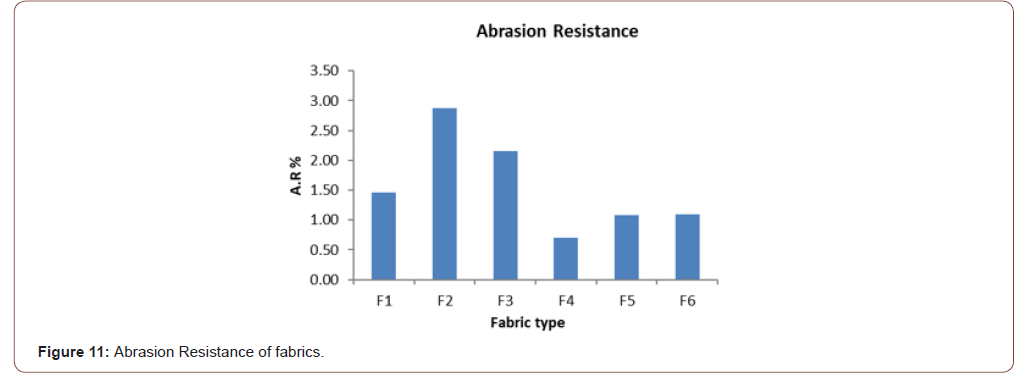
Abrasion resistance: The abrasion resistance of different fabrics is shown in Figure 11. The % loss in weight after a fixed number of abrasion cycles is found to be least in vortex yarn fabrics. Hence it can be said that vortex yarn sustains higher to the abrasive forces. This result can support the use of vortex yarns in the fabrics where the abrasion resistance is important.
Pilling tests: The pilling property of different fabrics made of three different yarns is shown in Figure 12. The pilling is more prominent in vortex yarn fabric by visually assessing the fabrics for pill formation after a fixed number of abrasion cycles. The behavior of vortex yarn and ring yarn suiting fabrics is same. The performance of vortex yarn light weight shirting fabric is poor if pilling performance is taken into consideration.
Drapability: Figure 13 shows the drapability of different fabrics and is being compared to conclude that drape coefficient for suiting fabric is higher than that of shirting fabrics. The vortex yarn fabrics are found to be stiffer and less Drapable than other two yarn fabrics. Hence the free falling of fabric is poor in case of vortex yarn fabrics.
Air permeability: Air permeability of the different fabrics is shown in Figure 14. It depends on fabric porosity, which means the number of canals in the textile fabric, its cross-section and shape. The Air permeability follows same trend in both shirting and suiting fabric, specifically highest in compact yarn and lowest in ring yarn fabric and intermediate in vortex yarn fabric. Here the ring yarn has higher hairiness which reduces the air flow and compact yarn is basically a compact structure and lesser hairiness allows maximum airflow.
Thermal properties (Alambeta): The thermal properties were tested and shown in Figure 15 for different fabrics. The Alambeta tester gives idea about thermal properties of fabric, here it is found that conductivity and thermal resistance of suiting (or heavy weight) fabric is higher than shirting fabric. The measurement result of thermal conductivity is based on equation below

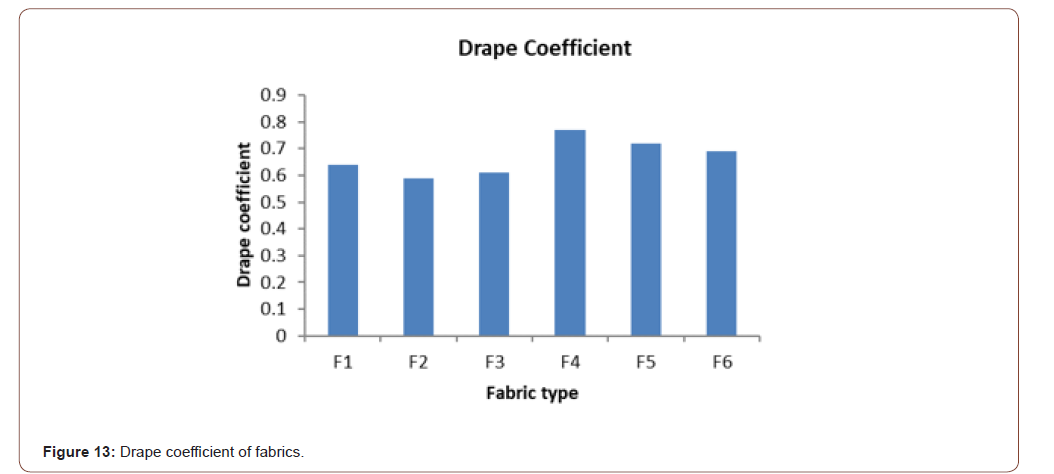
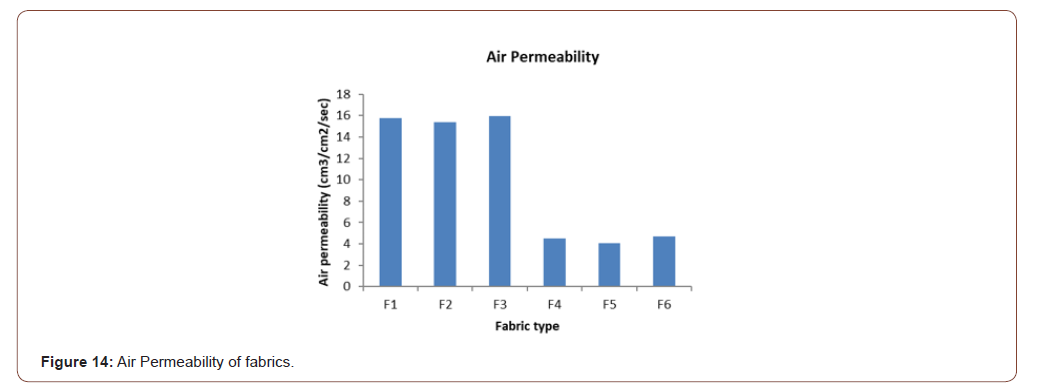
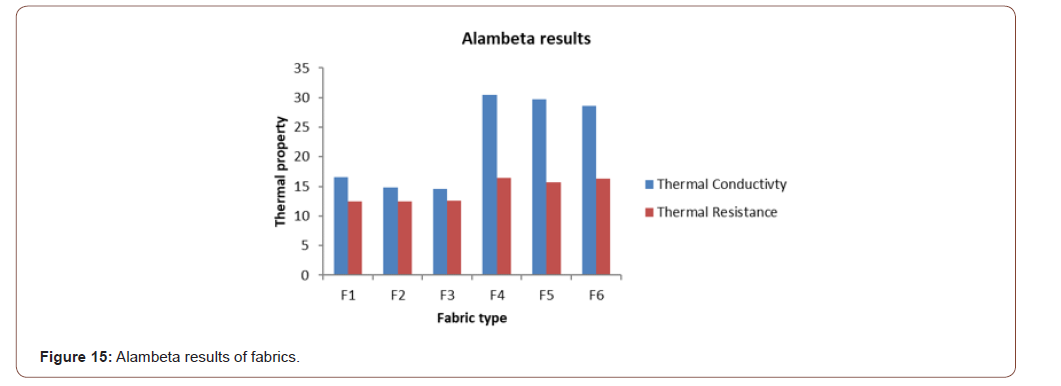
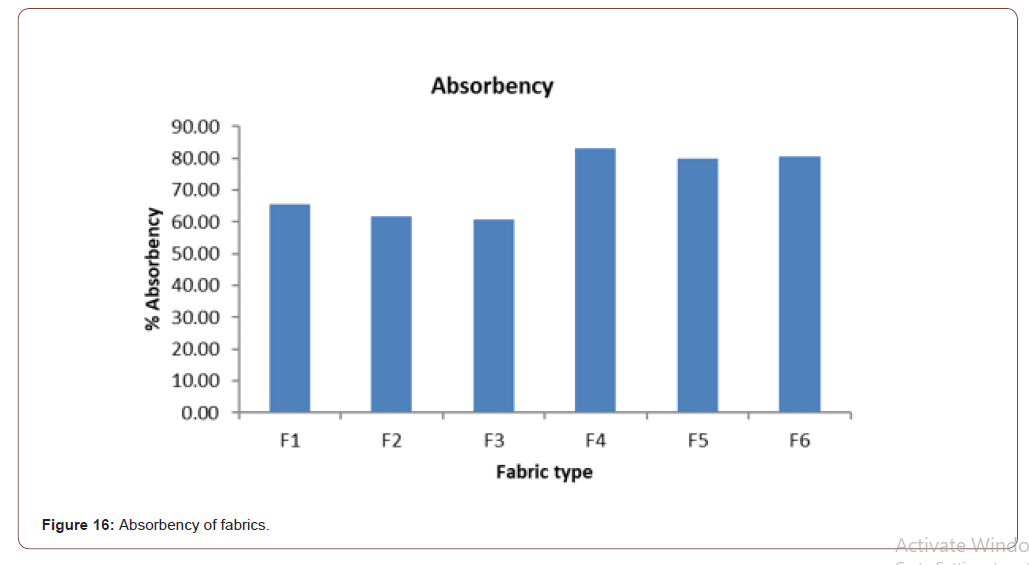
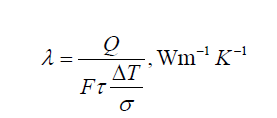
where:
Q - amount of conducted heat,
F - area through which the heat is conducted,
τ - time of heat conducting,
ΔT - drop of temperature,
σ - fabric thickness.
Here the thermal conductivity is maximum for vortex yarn fabrics in both suiting and shirting ranges.
Thermal resistance is a very important parameter from the point of view of thermal insulation. Thermal insulation values for shirting fabrics is same for all the three fabrics and in case of suiting fabric the thermal insulation or resistance is maximum for Vortex yarn fabric.
Absorbency: Figure 16 shows the absorbency of different fabrics. It is concluded that vortex yarn fabrics absorbency is higher than other two types of fabrics. This can be due to its twist structure which has higher porosity and hence absorbing more liquid and that too quickly.
Objective evaluation of fabric hand: The Kawabata evaluation system KES was used to measure the low-stress mechanical properties of the fabrics. The four modules KES FB1, KES FB2, KES FB3 and KES FB4 were used to evaluate the tensile and shear, bending, compression and surface properties of the fabrics respectively. For each sample ten readings were measured both in wrap and weft directions. Furthermore, the Kawabata set of equations were used to evaluate the primary hand values like KOSHI (stiffness), NUMERI (smoothness), SHARI (crispness) and FUKURAMI (softness) etc. and the total hand values were estimated using standard hand equation prescribed by Kawabata. The primary hand value and the total hand value obtained were in a scale of 0-10 and 0-5 respectively. The primary and total hand value of different fabrics are shown in Table 5. It is interesting to note that the vortex yarn fabric shows a negative hand value for shirting application. The results clearly depict that the vortex yarn fabrics have lower THV than the ring and compact yarn fabrics in both suiting and shirting applications. The compact yarn fabrics give a better hand value than the other two fabrics.
Table 3:Yarn properties.
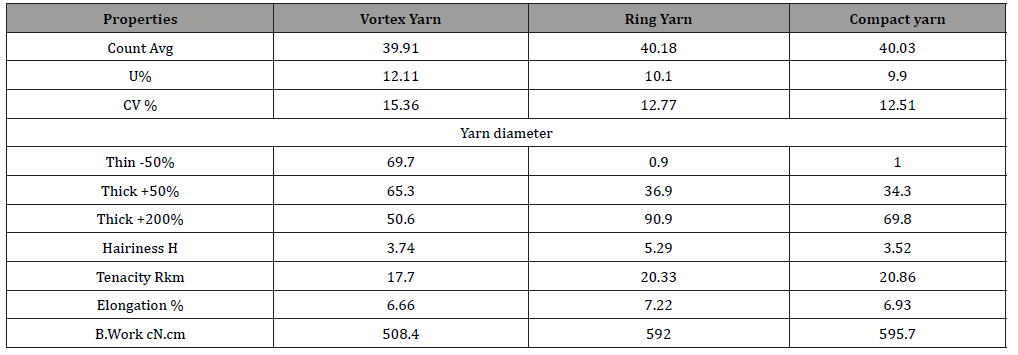
Table 4:Fabric properties.
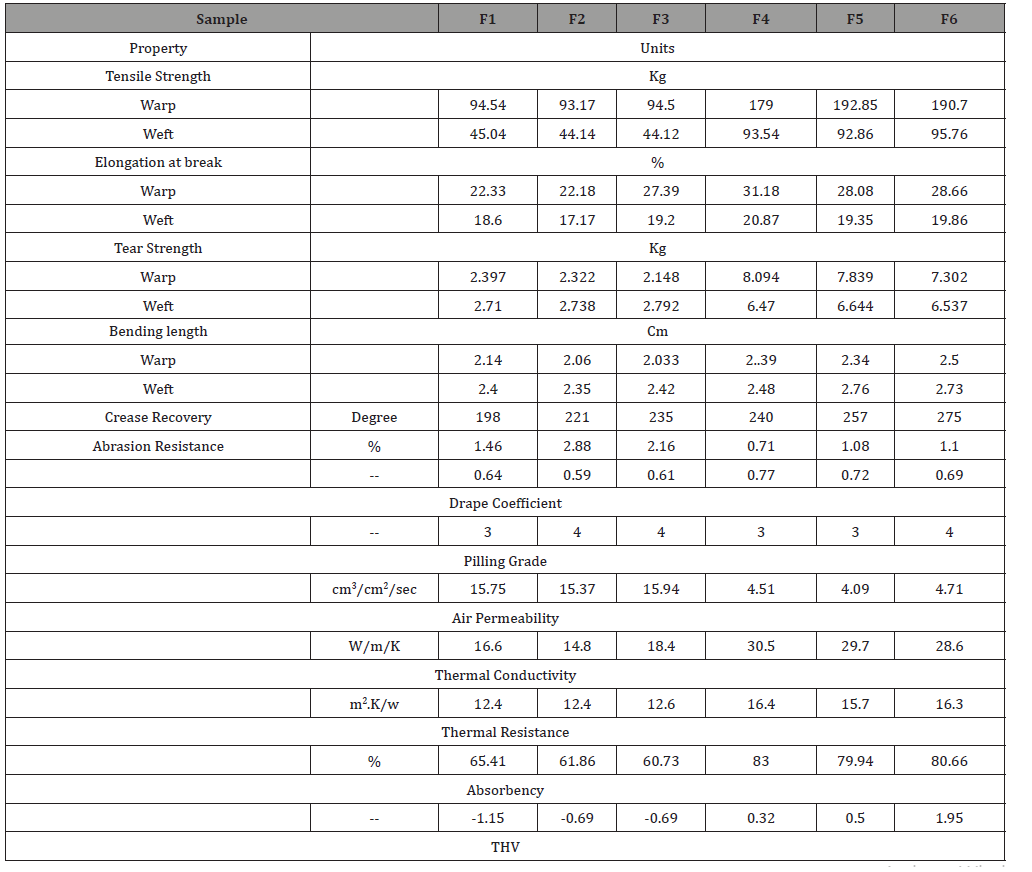
Table 5:Total hand value chart.

It is found that the stiffness and fullness/softness of the vortex yarn fabric is better than ring and compact. The crispness and spreading property of vortex yarn fabric is poorer than ring and compact yarn fabrics.
Conclusions
The vortex yarn is poor in strength and elongation and is also having more irregularities and uneven compared to ring and compact yarns. The vortex yarn has a higher diameter for same count and hence being more porous than ring and compact yarns. The hairiness is far less in vortex yarns compared to ring yarn owing to its structure and yarn formation technique. The tensile properties of vortex yarn fabrics are poorer owing to poorer tensile behavior of parent yarn. The abrasion resistance of vortex yarn fabric is better than other two fabrics and its pilling performance is also better than ring yarn fabrics. The air permeability of vortex yarns is intermediate between compact and ring yarns and its thermal properties i.e. thermal conductivity and thermal resistance are better than the ring and compact yarn fabrics. The drapability and crease recovery of vortex yarn fabrics is poor, but its moisture or liquid absorbency is better than ring-spun or compact-spun yarn fabric. The handle values of the vortex yarn fabrics were not so satisfactory compared to other types of yarns but surely its other properties can be utilized for some specialized application where fabric handle has a very least role to play. Vortex yarn is expected to invade other global markets in one way or other mainly because of high productivity of the vortex spinning system.
Acknowledgement
None.
Conflict of Interest
The authors declared no potential conflicts of interest with respect to the research, authorship, and /or publication of this article.
References
- Behera BK, Ishtiaque SM, Chand S (1997) Comfort properties of fabrics woven from ring-, rotor-, and friction-spun yarns. Journal of the Textile Institute 88 (3): 255-264.
- Ortlek HG, Ulku S (2005) Effect of some variables on properties of 100% cotton vortex spun yarn. Textile Research Journal 75(6): 458-461.
- Ülkü S, Özipek B, Acar M (1995) Effects of opening roller speed on the fiber and yarn properties in open-end friction spinning. Textile Research Journal 65(10): 557-563.
- Bansal P, Maity S, Sinha SK (2019) Effects of process parameters on tensile and recovery behavior of ring-spun cotton/lycra denim yarn. Journal of the Institution of Engineers (India): Series E 100: 37-45.
- Özdil N, Marmaralı A, Kretzschmar SD (2007) Effect of yarn properties on thermal comfort of knitted fabrics. International Journal of Thermal Sciences 46(12): 1318-1322.
- Krifa M, Ethridge MD (2006) Compact spinning effect on cotton yarn quality: Interactions with fiber characteristics. Textile Research Journal 76(5): 388-399.
- Kilic M, Buyukbayraktar RB, Kilic GB, Aydin S, Eski N (2014) Comparing the packing densities of yarns spun by ring, compact and vortex spinning systems using image analysis method. Indian Journal of Fibre & Textile Research 39: 351-357.
- Ishtiaque SM, Sharma IC, Sharma S (1993) Structural mechanics of siro yarn by microtomy. Indian Journal of Fibre & Textile Research 18: 116-119.
- Zheng S, Zou Z, Shen W, Cheng L (2012) A study of the fiber distribution in yarn cross section for vortex-spun yarn. Textile Research Journal 82(15): 1579-1586.
- Basal G (2003) The structure and properties of vortex and compact spun yarns.
- Erdumlu N, Ozipek B, Oztuna AS, Cetinkaya S (2009) Investigation of vortex spun yarn properties in comparison with conventional ring and open-end rotor spun yarns. Textile Research Journal 79(7): 585-595.
- Zou Z, Cheng L, Xue W, Yu J (2008) A study of the twisted strength of the whirled airflow in Murata vortex spinning. Textile Research Journal 78(8): 682-687.
- Prahsarn C, Barker RL, Gupta BS (2005) Moisture vapor transport behavior of polyester knit fabrics. Textile Research Journal 75(4): 346-351.
- Rameshkumar C, Anandkumar P, Senthilnathan P, Jeevitha R, Anbumani N (2008) Comparative studies on ring rotor and vortex yarn knitted fabrics. Autex Research Journal 8(4): 100-105.
- Behera BK, Mishra R (2007) Comfort properties of non-conventional light weight worsted suiting fabrics. Indian Journal of Fibre & Textile Research 32: 72-79.
- Nayak RK, Punj SK, Chatterjee KN, Behera BK (2009) Comfort properties of suiting fabrics. Indian Journal of Fibre & Textile Research 34: 122-128.
- Pramanik P, Patil VM (2009) Low stress mechanical behaviour of fabrics obtained from different types of cotton/nylon sheath/core yarn. Indian Journal of Fibre & Textile Research 34: 155-161.
-
Lekhani Tripathi, Bijoya Kumar Behera. Comparative Studies on Ring, Compact and Vortex Yarns and Fabrics. 6(5): 2020. JTSFT.MS.ID.000647.
-
Air vortex spinning, Ring spinning, Compact spinning, Fabric handle, Comfort
-

This work is licensed under a Creative Commons Attribution-NonCommercial 4.0 International License.






